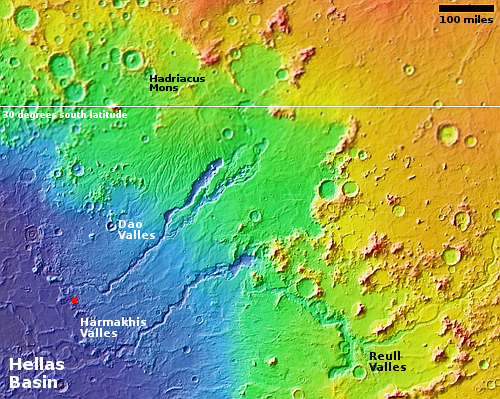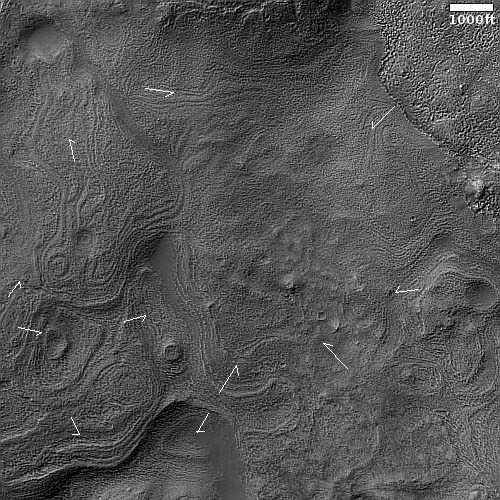Swirls draining into a Martian crater
Cool image time! The picture to the right, rotated, cropped, reduced, sharpened, and annotated to post here, was taken on April 8, 2023 by the high resolution camera on Mars Reconnaissance Orbiter (MRO).
The picture shows a terrain of swirls and terraced mesas. Because the shadows are deceptive, I have annotated the picture to show the actual drainage pattern of those swirls, suggesting that whatever material forms these swirls is not only draining about 200-250 feet down into the low point at the picture’s center, the swirls are also draining toward the small 1,000-foot-wide crater in the upper left. That crater however appears to lie on top of the swirls, which means it came after them.
What are the swirls made of?

On the overview map to the right the red dot near the outlet of Dao Vallis into Hellas Basin marks this location. The latitude is 40 degrees south latitude, and Dao Vallis is a canyon that is apparently filled with what looks like glacial ice for most of its length. Thus, the location suggests the swirls are glacial ice.
Yet, these swirls also resemble a feature found only in Hellas Basin dubbed taffy terrain. What makes up taffy terrain is still a matter of dispute. According to this 2014 paper,
The apparent sensitivity to local topography and preference for concentrating in localized depressions is compatible with deformation as a viscous fluid.
What that viscous fluid was remains unclear. Some scientists think it is the combined action of ice and salt. Others think it is some volcanic or melt process.
Your guess is as good as mine.
On Christmas Eve 1968 three Americans became the first humans to visit another world. What they did to celebrate was unexpected and profound, and will be remembered throughout all human history. Genesis: the Story of Apollo 8, Robert Zimmerman's classic history of humanity's first journey to another world, tells that story, and it is now available as both an ebook and an audiobook, both with a foreword by Valerie Anders and a new introduction by Robert Zimmerman.
The print edition can be purchased at Amazon or from any other book seller. If you want an autographed copy the price is $60 for the hardback and $45 for the paperback, plus $8 shipping for each. Go here for purchasing details. The ebook is available everywhere for $5.99 (before discount) at amazon, or direct from my ebook publisher, ebookit. If you buy it from ebookit you don't support the big tech companies and the author gets a bigger cut much sooner.
The audiobook is also available at all these vendors, and is also free with a 30-day trial membership to Audible.
"Not simply about one mission, [Genesis] is also the history of America's quest for the moon... Zimmerman has done a masterful job of tying disparate events together into a solid account of one of America's greatest human triumphs."--San Antonio Express-News
Cool image time! The picture to the right, rotated, cropped, reduced, sharpened, and annotated to post here, was taken on April 8, 2023 by the high resolution camera on Mars Reconnaissance Orbiter (MRO).
The picture shows a terrain of swirls and terraced mesas. Because the shadows are deceptive, I have annotated the picture to show the actual drainage pattern of those swirls, suggesting that whatever material forms these swirls is not only draining about 200-250 feet down into the low point at the picture’s center, the swirls are also draining toward the small 1,000-foot-wide crater in the upper left. That crater however appears to lie on top of the swirls, which means it came after them.
What are the swirls made of?

On the overview map to the right the red dot near the outlet of Dao Vallis into Hellas Basin marks this location. The latitude is 40 degrees south latitude, and Dao Vallis is a canyon that is apparently filled with what looks like glacial ice for most of its length. Thus, the location suggests the swirls are glacial ice.
Yet, these swirls also resemble a feature found only in Hellas Basin dubbed taffy terrain. What makes up taffy terrain is still a matter of dispute. According to this 2014 paper,
The apparent sensitivity to local topography and preference for concentrating in localized depressions is compatible with deformation as a viscous fluid.
What that viscous fluid was remains unclear. Some scientists think it is the combined action of ice and salt. Others think it is some volcanic or melt process.
Your guess is as good as mine.
On Christmas Eve 1968 three Americans became the first humans to visit another world. What they did to celebrate was unexpected and profound, and will be remembered throughout all human history. Genesis: the Story of Apollo 8, Robert Zimmerman's classic history of humanity's first journey to another world, tells that story, and it is now available as both an ebook and an audiobook, both with a foreword by Valerie Anders and a new introduction by Robert Zimmerman.
The print edition can be purchased at Amazon or from any other book seller. If you want an autographed copy the price is $60 for the hardback and $45 for the paperback, plus $8 shipping for each. Go here for purchasing details. The ebook is available everywhere for $5.99 (before discount) at amazon, or direct from my ebook publisher, ebookit. If you buy it from ebookit you don't support the big tech companies and the author gets a bigger cut much sooner.
The audiobook is also available at all these vendors, and is also free with a 30-day trial membership to Audible.
"Not simply about one mission, [Genesis] is also the history of America's quest for the moon... Zimmerman has done a masterful job of tying disparate events together into a solid account of one of America's greatest human triumphs."--San Antonio Express-News


